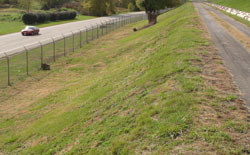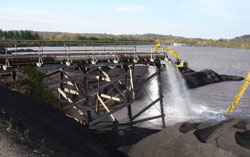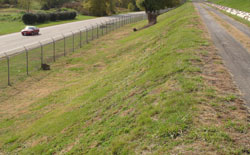
Storing Ash Safely
Fly ash ponds require monitoring and maintenance
- By Robert M. Cords, P.E., Prasad S. Rege, P.E.
- Apr 27, 2009
 Many landfills and retention ponds used to store fly ash are aging, having been designed and constructed as far back as the 1950s using unsophisticated and less rigorous methods than those used today.
Many landfills and retention ponds used to store fly ash are aging, having been designed and constructed as far back as the 1950s using unsophisticated and less rigorous methods than those used today.
Evidence of this has been found in the media with the most prominent story appearing in December 2008, when the containment dike of the coal-fired TVA Kingston Power Plant in Tennessee failed. While the U.S. Environmental Protection Agency does not regulate fly ash as a hazardous waste, the coal combustion byproduct does contain many toxins—including arsenic, which, in sufficient concentrations, can be hazardous. Because of this failure, regulators are developing more stringent dam/dike safety regulations.
Until those rules are released, fly ash dikes associated with landfills or retention ponds will still be subject to erosion, instability, and seepage problems. Managers can reduce these risks through proper storage design and regular inspections as well as routine monitoring and maintenance.
Design
A typical storage or ash landfill is designed very much like a conventional solid waste landfill or retention pond. The landfill/pond walls must resist seepage and remain stable.
 Landfill/pond slope designers use the principles of small earthen dam design. They perform seepage analyses and consider such items as seepage paths, hydraulic heads, and coefficient of permeability of the material.
Landfill/pond slope designers use the principles of small earthen dam design. They perform seepage analyses and consider such items as seepage paths, hydraulic heads, and coefficient of permeability of the material.
Also, leachate that could contain hazardous components must not be allowed to leave the facility and infiltrate groundwater. Landfills and retention ponds must be properly lined with suitable cohesive soil and geosynthetic liners to minimize this risk.
Slope stability depends on construction materials as well as subsurface soil conditions below the embankments and ponds. These ash landfills/ponds need to be designed to prevent localized slope failures that weaken the embankment or global failure that causes the entire embankment to rupture.
Slopes cannot be too steep. Typically slopes greater than two horizontal (H) to one vertical (V) are prone to erosion, slip failures, and global stability failures. Soil types, strength of the soils utilized for construction of these slopes, and groundwater conditions all impact slope stability.
Maintenance
Embankments must be maintained to prevent erosion to the face of the embankment or at the toe of the slopes. Erosion along the face reduces the cross-section of the embankment, thus lowering the overall safety factor against a localized or global rotational embankment slope failure. Once a slope starts to erode, the rate at which future erosion will occur increases. Likewise, erosion at the toe of the slope reduces the weight of soil resisting global stability failure.
In any case, proper slope design, along with good vegetative cover or riprap layer, must be maintained. Animal infestations (such as groundhogs) can cause significant tunneling that will lead to erosion, seepage conduits, and damage to slope vegetation. Such burrow holes need to be located and backfilled with suitable cohesive soils.
Inspection and monitoring
To limit the potential for failure and reduce the liability associated with environmentally contaminating downstream areas, facility owners should:
- Review the facility design. This may entail performing geotechnical explorations and piezometer installation to assess the subsurface soil and groundwater conditions in the embankment and foundation. Assess the global stability of the current structure to determine if the embankments should be reworked.
- Perform periodic inspections of the embankments to assess whether there is erosion or leakage/seepage from the holding ponds that may weaken the embankments. These should be done on an annual basis at a minimum.
- Install monitoring wells and perform routine chemical analysis of the groundwater to assess whether the pond/landfill is leaching hazardous substances and transporting them beyond the limits of the facility.
Owners should act immediately to correct issues identified during any inspection and monitoring. The environmental risks and cost associated with a dam/dike failure could be substantial.
About the Authors
Robert M. Cords, P.E., is a national sector leader for energy, power generation, and transmission at Terracon. Prasad S. Rege, P.E., is the office manager of the firm's Columbus, Ohio, office. Terracon is an employee-owned engineering consulting firm providing geotechnical, environmental, construction materials, and facilities services from nearly 100 offices nationwide.